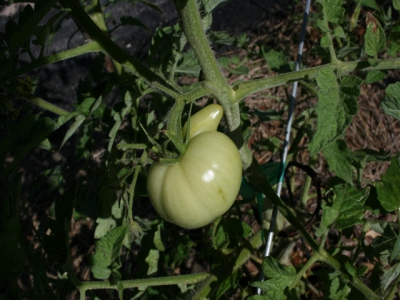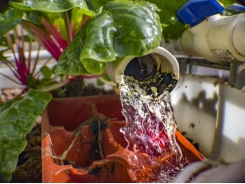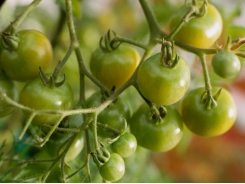Things to think about when going under cover

It’s extremely risky to plant tomatoes in the open in areas where hail and three-day spells of rain are common.
Tomatoes growing in soil in an economical tunnel.
The latter causes disease, while the former, of course, destroys your crop. The only option, then, is to grow your tomatoes under plastic or net covers. Net covers are usually used to cool the crop in very hot regions. When temperatures reach about the mid-30s, pollination can become a problem and cause gaps in production due to few fruit being set during hot spells.
You need to consult with a reputable netting manufacturer to establish the type most suitable for reducing heat damage.
Another important aspect when going the netting route is to form the canopy so that it sheds hail during a hailstorm, or else the structure will collapse. Netting also ensures the crop stays warmer at night than it would if grown in the open.
Plastic, on the other hand, has the advantage of keeping rain off in wetter areas so that the only fungal disease you’ll usually have to spray for will be powdery mildew. This doesn’t need free moisture on the leaves to develop, but develops gradually and is easier to control.
Better growth
The effect on night temperatures is also greater with plastic. This means much better growth is possible, especially in the early season. The downside is that it will be hotter under the covering than outside – a limitation in hot areas unless some sort of cooling system is used. I’ve solved this problem by using small tunnels made from 7m-long pipe hoops and 5m-wide plastic to which 1,5m of hail netting is stitched on both sides with polypropylene twine.
The extra half metre is dug into the soil to hold the plastic ridged over the structure. This system allows air to flow in from the lower 1m either side, while the hot air is expelled from the open ends. I have no pollination problems on the Highveld with such tunnels.
Into the soil
In tunnels, it’s common to plant the tomatoes into plastic bags with wood shavings and fertilised with hydroponic mixtures. There’s nothing wrong with this, but it is expensive. Personally, I find planting into the soil easy and effective. The secret is to get the soil into a good condition by using a lot of compost and/or manure. This will do away with many potential problems.
I’ve been planting tomatoes in this way for 10 years – that is, planting into the same soil which has never been fumigated.
The organic fertiliser is lightly hoed into the top 6cm and no further digging done. With this system you have to choose a variety resistant to soil-borne diseases such as Verticillium and Fusarium wilts and, depending on the area, bacterial wilt. Eelworm resistance is also a must. There are plenty of such varieties to choose from. And once the soil is healthy, even these diseases pose less of a problem.
Careful calculations
Although the kind of tunnels I’m talking about are far cheaper per square metre and planting into soil saves a lot more costs, you have to carefully calculate whether this set-up is a viable proposition. Tomatoes are mostly produced in warm, dry areas under economical conditions, and often the cost of transport from there is less than the cost of erecting tunnels. As soon as we talk about plastic structures, many think of being able to produce in winter in cold areas.
This is not possible without heating – and heating costs more than transport from the main production areas. All we can hope for is a temperature advantage that allows us to start off a little earlier in spring and to continue a little later in autumn.
New transplants planted early can be given added protection against a late frost with floating frost covers. I’d suggest rather using the tunnels for Swiss chard or lettuce in winter than trying to produce tomatoes in frosty conditions.
Có thể bạn quan tâm
Phần mềm

Phối trộn thức ăn chăn nuôi

Pha dung dịch thủy canh

Định mức cho tôm ăn

Phối trộn phân bón NPK

Xác định tỷ lệ tôm sống

Chuyển đổi đơn vị phân bón

Xác định công suất sục khí

Chuyển đổi đơn vị tôm

Tính diện tích nhà kính

Tính thể tích ao hồ




 6 Interesting Benefits Of Orach
6 Interesting Benefits Of Orach  Watch out for powdery mildew
Watch out for powdery mildew